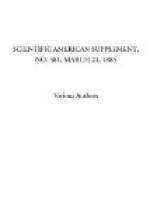Pupils who cannot or who do not wish to go over the entire field of the programme stop here, and are now capable of earning their living and of lightening the load that oppresses their parents.—Science et Nature.
* * * * *
MACHINE FOR POLISHING BOOTS AND SHOES.
The principle of an apparatus for blackening boots and shoes dates back to 1838, the epoch at which a machine of this kind was put into use at the Polytechnic School. Since then it seems that not many applications have been made of it, notwithstanding the services that a machine of this kind is capable of rendering in barracks, lyceums, hotels, etc. Mr. Audoye, an inventor, has recently taken up the question again, and has proposed to The Societe d’Encouragement a model that gives a practical solution of it. The use of this will allow a notable saving in time and trouble to be effected.
This brush (see engraving) revolves around a horizontal axle supported by a cast iron frame similar to that of a sewing machine. Motion is communicated to it by a double pedal, which actuates a connecting rod and a system of pulleys. The external surface of the brush contains three channels in which the foot gear to be polished is successively placed. In the first of these the dust and mud are removed, in the second the blacking is spread on, and in the third the final polish is obtained.
[Illustration: MACHINE FOR POLISHING BOOTS AND SHOES.]
In order to guide the blacking to that part of the brush which is to receive it, Mr. Audoye protects the lower part of the latter by a half-cylinder of sheet iron. On this there is placed a vessel containing the blacking, and into which dips a copper cylinder having a grooved surface. The horizontal axis of this cylinder is movable; when at rest it is so placed that the cylinder is an inch or so below the brush, but when the operator pulls a button that is within reach of his left hand, the axis is lifted, a contact takes place between the brush and the cylinder, and the former is thus given a rotary motion. As the cylinder still continues to dip into the blacking, the latter is thus spread ever the brush.—La Genie Civil.
* * * * *
PERSONAL SAFETY WITH THE ELECTRIC CURRENTS.
To the Editor of the Scientific American:
In your paper of the 21st of February there is an article on personal safety with electric currents, by Prof. A.E. Dolbear. He says that a Holtz machine may give through a short wire a very strong current. For if E = 50,000 volts, R = 0.001 ohm, then C = 50000/0.001 = 50,000,000 amperes. Now that is a very large quantity of electricity, and is equal to an enormous horse power. I think the person receiving that charge would not need another. According to Ohm’s law, the strength of current




